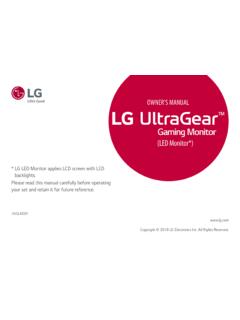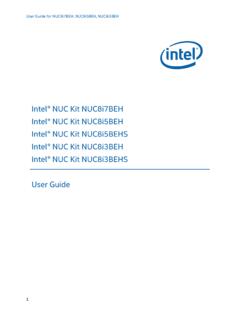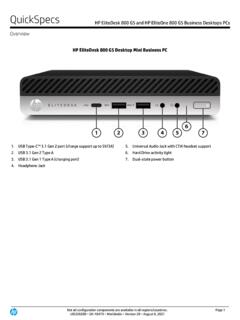Transcription of VESA Enhanced Display Data Channel (EDDC) Standard …
1 E-DDC 39899 Balentine Drive, Suite 125 Phone: 510 651 5122 Newark, CA 94560 Fax: 510 651 5127 VESA Enhanced Display Data Channel (EDDC) Standard Version December 26, 2007 Purpose The purpose of this Standard is to define a communications Channel between an electronic Display ( a CRT, LCD, etc Display ) and a host system. The Channel may be used to carry configuration information to enable plug & play and allow optimum use of the Display . The Channel may also carry Display control information. Summary Today s computing and consumer electronic environments demands that systems offer user-friendly set-up. With the growing popularity of intuitive and simpler software user interfaces, hardware manufacturers are responding with plug-and-play systems and peripherals. However, for the user to receive full benefit from these advances, standardization is necessary. VESA, as the prominent standards organization for graphics subsystems, has developed a communications Channel between the host and the Display .
2 This communication Channel offers basic configuration information plus a Standard way of communicating advanced functionality Errata or SCRs published Adopted April 19, 2013: E-DDC Address Update NXP v2 1 Summary of the Proposed Change(s) for E-DDC Address Update SCR The list of devices that can be connected to the same I C / DDC bus doesn t reflect all the modules we have today on DDC bus in HDMI and DisplayPort systems. IPR (Intellectual Property Rights) declaration, if any N/A Benefits as a Result of the Changes Avoid conflict with other devices connected on the I C / DDC bus. Assessment of the Impact It s just a clarification of slave addresses already allocated by other specifications using the Display Data Channel . No change of features, protocol or electrical specification. Analysis of the Device Hardware Implication The hardware implementation is mandatory by the other specifications, so the slave address allocation is already done as soon as the product respects the features of the corresponding specification.
3 About conflict between Audio Processor and DisplayPort Dual-Mode Video Adaptor, these are not expected to co-exist on the same physical DDC bus in practice. Analysis of the Device Software Implications No software change is needed. Analysis of the Compliance Test & Interop Implications Already tested in different Compliance Tests (HDMI, HDCP, DP, DP Dual Mode). New Referenced Documents Resulting from Change 1. High-bandwidth Digital Content Protection System Revision , July 2009. 2. VESA DisplayPort Dual-Mode Standard Version 1, February 2012. 3. High-Definition Multimedia Interface specification Version , March 2013. 4. Display Data Channel Command Interface Standard Version , Oct 29, 2004. 2 Proposed Document Change(s) or Addition(s) This section captures the list of proposed document changes in the specification. Display Data Channel (DDC) A protocol based on I2C and used on a bi- directional data Channel between the Display and host.
4 This protocol accesses devices at I2C addresses of A0h / A1h or A4h / A5h. The DDC Channel is used by HDMI, DP and DisplayPort Dual Mode standards for purposes beyond EDID data transport. The I2C slave/device addresses used by these standards are listed in Table 2- 2. The intended purposes of these addresses are described in those respective standards. DDC addresses (A0h / A1h and A4h / A5h) Under DDC, each pair of I2C slave addresses (A0h/A1h and A4h/A5h) allows 256 bytes of data to be accessed. Larger data structures, up to 32K bytes, can be accessed using the E- DDC addressing technique see section Other DDC addresses Table 2- 2 lists the DDC/I C addresses that are defined by DDC, HDMI, DP and DisplayPort Dual Mode standards. Table 2- 2: Normative Addresses I C Slave Address Specification 0x74h/75h Reserved for HDCP (Primary Link Port) [1] 0x76h/77h Reserved for HDCP (Secondary Link Port) [1] 0x80h/81h Reserved for DisplayPort (Dual Mode Video Adaptor[2] 0xA8h/A9h Reserved for HDMI[3] 0x6Eh/6Fh Reserved for DDC/CI Display for host communication ( MCCS)[4] Note: Given that DisplayPort Dual Mode Video Adaptor uses the same Slave Address as that of Audio Processor, they can t co- exist on the same physical DDC bus.)
5 VESA Enhanced Display Data Channel Standard Version Copyright 1994 - 2007 Video Electronics Standards Association Page 1 of 44 E-DDC 39899 Balentine Drive, Suite 125 Phone: 510 651 5122 Newark, CA 94560 Fax: 510 651 5127 VESA Enhanced Display Data Channel (EDDC) Standard Version December 26, 2007 Purpose The purpose of this Standard is to define a communications Channel between an electronic Display ( a CRT, LCD, etc Display ) and a host system. The Channel may be used to carry configuration information to enable plug & play and allow optimum use of the Display . The Channel may also carry Display control information. Summary Today s computing and consumer electronic environments demands that systems offer user-friendly set-up. With the growing popularity of intuitive and simpler software user interfaces, hardware manufacturers are responding with plug-and-play systems and peripherals.
6 However, for the user to receive full benefit from these advances, standardization is necessary. VESA, as the prominent standards organization for graphics subsystems, has developed a communications Channel between the host and the Display . This communication Channel offers basic configuration information plus a Standard way of communicating advanced functionality. VESA Enhanced Display Data Channel Standard Version Copyright 1994 - 2007 Video Electronics Standards Association Page 2 of 44 Table of Contents Preface .. 5 Acknowledgements .. 6 Revision History .. 7 1. Overview .. 8 Summary .. 8 Background .. 9 Significant Changes in Current E-DDC Revision .. 10 Reference Documents .. 10 2. Definitions .. 11 Data formats .. 11 Enhanced Extended Display Identification Data: E-EDID .. 11 Enhanced Extended Display Identification Data Extension Blocks .. 11 Display Identification: DisplayID .. 11 Communication Protocols .. 11 I2C Bus .. 12 Display Data Channel (DDC).
7 12 DDC addresses (A0h / A1h and A4h / A5h) .. 12 Enhanced DDC (E-DDC) .. 12 Segment pointer (60h) .. 12 Typical Operation Sequences .. 13 DDC Command Interface (DDC/CI) .. 16 Display Types .. 16 Non-DDC Display .. 16 DDC Display .. 16 Enhanced DDC Display .. 16 Host System Types .. 16 Non-DDC Host .. 16 DDC Host .. 16 E-DDC Host .. 17 3. Co-existance of EDID and DisplayID Display Capability Structures .. 18 Example of Host Operation .. 18 4. DDC/E-DDC - General .. 19 Signal Termination .. 19 Timing .. 19 DDC / E-DDC Timing .. 19 EDID Availability .. 19 5. Data Transfer Protocols .. 20 DDC and E-DDC .. 20 Basic operation for E-DDC access of EDID: .. 20 Basic Operation for E-DDC Access of DisplayID: .. 21 6. Command Structures .. 22 Read at the Current Address .. 22 DDC Random Read Operation .. 24 VESA Enhanced Display Data Channel Standard Version Copyright 1994 - 2007 Video Electronics Standards Association Page 3 of 44 DDC Sequential Read Operation.
8 24 E-DDC Random Read Operation .. 26 E-DDC Sequential Read Operation .. 27 7. Physical Connections Video Interfaces .. 28 VGA .. 28 Mechanical .. 28 VGA Connector Pinouts .. 29 Power requirements .. 29 Digital Visual interface (DVI) .. 29 Mechanical .. 30 Connector Pin-out .. 31 Power Requirements .. 31 High Bandwidth Digital Multimedia Interface (HDMI) .. 32 Mechanical HDMI-A .. 32 Mechanical HDMI-B .. 33 HDMI Connector Pin-outs .. 34 Power Requirements .. 34 DisplayPort .. 35 Mechanical External DisplayPort .. 35 DisplayPort External Connector Pin-Out .. 36 Power Requirements .. 36 8. DisplayPort and DDC/E-DDC .. 37 9. Enhanced DDC System/ Display Combinations .. 38 Interoperability .. 38 DDC Host System Connected to an E-DDC Display .. 38 Enhanced DDC Host Connected to a DDC Display .. 38 10. E-DDC Compliance .. 39 Older Designs .. 39 New Display Designs .. 39 New Host Subsystem Designs .. 39 I 2C Bus .. 39 E-DDC Unique Features.
9 39 Segment Pointer .. 39 Power Pin .. 40 EDID / DisplayID Available with Display Powered Off .. 40 Co-existence of E-DDC, DDC/CI and HDCP .. 40 11. Appendix A: Answers to Commonly Asked Questions .. 41 12. Appendix B: Main Contribution History .. 43 VESA Enhanced Display Data Channel Standard Version Copyright 1994 - 2007 Video Electronics Standards Association Page 4 of 44 Tables Table 1-1: Main Contributors to Version 1, Revision 2 .. 6 Table 1-1: Reference Documents .. 10 Table 2-1: Summary of DDC Communication Modes .. 11 Table 5-1: DDC and E-DDC Device Addresses - EDID .. 20 Table 5-2: DDC and E-DDC Device Addresses - DisplayID .. 20 Table 7-1: 15-pin D-type Connector Pinouts .. 29 Table 7-2: DVI Connector Pin-out .. 31 Table 7-3: HDMI-A & HDMI-B Connector Pin-outs .. 34 Table 7-4: DisplayPort External Connector Pin-out .. 36 Table 10-1: Segment pointer tests .. 39 Table 10-2: Power Pin Tests .. 40 Table 10-3: EDID and/or DisplayID Read with no Display Power.
10 40 Table 11-1: Answers to Commonly Asked Questions about E-DDC and the VGA Interface .. 41 Table 12-1: Main Contributors to E-DDC Version .. 43 Table 12-2: Main Contributors to E-DDC Version .. 43 Figures Figure 2-1: E-DDC Segment Pointer and Block Layout .. 15 Figure 6-1: DDC Read at the Current Address .. 23 Figure 6-2: DDC random read operation .. 24 Figure 6-3: DDC Sequential Read Operation .. 25 Figure 6-4: E-DDC Random Read Operation .. 26 Figure 6-5: DDC Sequential Read Operation .. 27 Figure 7-1: VGA Socket .. 28 Figure 7-2: DVI -I Socket Drawing .. 30 Figure 7-3: DVI-D Socket Drawing .. 30 Figure 7-4: HDMI-A Connector .. 32 Figure 7-5: HDMI-B Connector .. 33 Figure 7-6: DisplayPort External Connector Receptacle .. 35 Figure 7-7: DisplayPort External Connector Plug .. 36 Figure 8-1: DisplayPort Mapping of I2C to AUX Channel .. 37 VESA Enhanced Display Data Channel Standard Version Copyright 1994 - 2007 Video Electronics Standards Association Page 5 of 44 Preface Intellectual Property Copyright 1994 - 2007 Video Electronics Standards Association.











